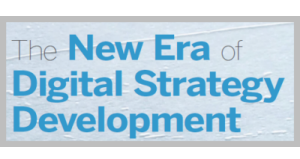7 Digital Strategies Leaders Can Apply To Prosper in the Next 5 Years
September 5, 2023
Creating the Virtuous Spiral:
7 Digital Strategies Leaders Can Apply To Prosper in the Next 5 Years
By Scott Klososky
There are case studies in most industries where one organization leverages technology to achieve the “Virtuous Spiral” and increase its financial and market share performance in the industry. They achieve this through amplifying profits by using digital strategy to grow topline revenue while at the same time lowering costs through automation and gains in efficiency. With their growing profits, they reinvest in more technology, amplify their results and move up in their industry’s list of top organizations.
The reverse is true. If an organization has a poor digital strategy process, it will struggle for profits and have little cash flow to put into technology, the one weapon that might have saved them. This can trigger the death spiral. We have seen this with companies like Blockbuster, Kodak and countless other large and small organizations.
If you want to trigger the Virtuous Spiral at your organization, it will take a combination of a well-designed digital strategy road-mapping process and high-beam leadership.
We define the concept of being a high beam leader as a person who can look forward five years in their industry in an accurate way. Once the organization can see this accurate future, they can make wise investments that will ensure they win in that future. All of this must be built into the digital strategy roadmap, funded and resourced so the strategy does not get pushed aside for day-to-day work.
When our organization helps clients develop the key dimensions – or areas of focus – for their digital strategies, we push them to add some of our high-beam ideas if these strategies can help them gain a two-year lead on their competition. The seven ideas below might help you add valuable dynamics that will take you to the next level.
Key Idea One – IT Decentralization
Many organizations remain too dependent on their IT department to provide technology progress. The concept of IT decentralization means efforts are made to move digital skills out to all departments in the organization so that 90% of the team who is not in IT can self-serve their own technology capability. This is a powerful concept that can help any size organization regardless of if they have one IT person or 200. To accomplish this spreading out of tech skills, you must put in a few new forms of governance to ensure the business side adheres to security and enterprise architecture standards. You will also need to greatly improve your training and education processes to help the business side gain much-needed digital skills. When this model is fully implemented, you end up with an organization that can accomplish 100% more with technology than when the vast amount of technology “work” is done by IT.
Key Idea Two – Integrating Generative AI into the Organization
This is the hottest area of technology today and for a good reason. We now have AI engines that can create content, ideas, answers, graphics, music, etc., at any user’s request. We are still in the early days of generative AI as a tool, and it will only get more powerful. Every organization must be experimenting with the practical everyday use of the AI engines that will explode into the market over the next few years. It is hard to overstate the impact of AIs that can co-work with your people to help them do pieces and parts of their jobs.
Key Idea Three – Developing Centaurs
A Centaur is a team member with highly developed human skills combined with a well-developed knowledge of technology tools. This term is used in fields such as the military and chess, where soldiers and players partner with technology to do what they do. We have now learned a Centaur who uses an AI can often out-skill an AI on its own. Think of Centaurs as the next level past a power user in any one software tool. A Centaur can use many different kinds of technology tools to accomplish tasks, and at the same time, they are highly evolved humans with a high emotional quotient and team skills. Whether you have called them Centaurs or not, you can probably already point to someone on your team approaching this status. When you identify that person, they are normally one of the most valuable people on your team. A winning digital strategy has a plan for developing more Centaurs in your organization!
Key Idea Four – Micro-Automations
There is a saying in the digital strategy world that goes like this: “Every organization has 1,000 automations that could be built, and they have finished 50 of the bigger ones.” The other 950 have not been done because they are small automations, such as creating bots that can move data from one system to the other while cleaning the data along the way, so humans don’t have to do that by hand in Excel. A winning digital strategy has an automation dimension focused on creating a process inventory and knocking out small automations that can save hours here and there. Add up all these hours over time, and we will free up vast amounts of time for team members to invest their skills in much more valuable ways. If you want profit amplification, automate processes faster and reap the cost savings and efficiencies.
Key Idea Five – Digital Customer Experience
Now that you are automating and lowering costs, the other side of profit amplification is growing topline revenue. That is where the digital customer experience comes in. A well-designed digital strategy always focuses on the technology customers see and use. Adding functionality that delights customers earns a digital halo. A digital halo is the feeling a customer has about you when they believe you are good at what you do and you are noticeably better at using technology than your competitors. This can include tools like websites, customer portals, customer data transfers, e-commerce, customer communication systems, etc. There is a reality that in your industry, there are customers who sense, or know for sure, that one company is better than the others at using technology. In a world where the younger generations are starting to rate their vendors and suppliers by how good their apps or websites are, having that digital halo is key if you want to spin up the Virtuous Spiral.
Key Idea Six – Data Activation
Every winning digital strategy has a focus on further leveraging data to win in the market. We have all been talking about data for decades, and still, we have barely scratched the surface of generating the value hidden in our databases. Data provides facts and insights that help us make better decisions. It can spotlight areas of our performance that we can change or leverage. In order to amplify profits, we can use customer data to improve topline revenue. We can create dashboards with more meaningful KPIs to run the organization with. Data is one of the most powerful assets an organization can harness, but this takes investment, work and creativity – it takes a great data strategy. Combine the data activation strategy dimension with IT decentralization and Centaurs, and you get the concept of citizen data scientists who can be all over the organization leveraging data to help you win!
Key Idea Seven – Digital Risk Management
A digital strategy cannot be all offense and no defense. Technology giveth and taketh away. By this, I mean the digital risks like cybersecurity force an organization to give back some of its hard-earned profits. Each powerful digital strategy accounts for growing a stronger cybersecurity position year to year. That is not the only digital risk, however. There is an innovation risk that a competitor will develop better technology and take away your digital halo with customers. There is also a coming AI risk with the use of AIs that are later proven to be biased or discriminatory, opening you up to lawsuits. This is a key dimension of a strategy, and although it is not the most exciting to think about, savvy high-beam leaders are also looking five years into the future to see the risks that must be avoided.
In closing, many more ideas can be baked into your digital strategy, so know the seven above are more to get you thinking in new ways about ingredients for your digital strategy. Effective modern leaders build a dynamic process for documenting and executing digital strategy roadmaps. Strong leaders learn to be high beams with how technology will impact their industry over the next five years. Wise modern leaders know that the digital strategy must, above all, create a good return on investment for all the work and projects that go into it.
These might be new skills you need to add to your leadership inventory. The good news is these are also fairly new for every other leader. You can evolve as a leader if you choose to learn and grow your digital strategy skills. And put in the hard work to get there!








